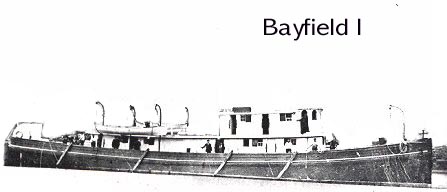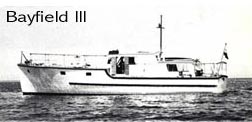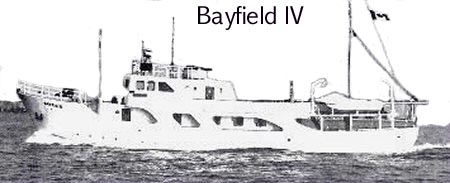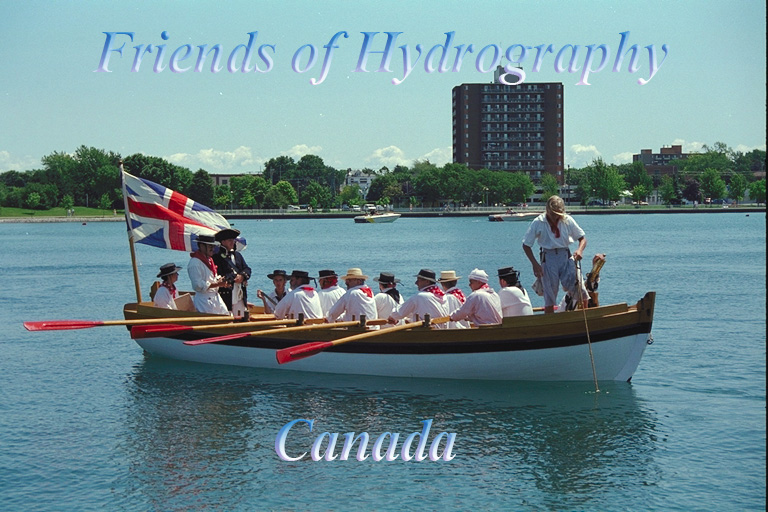Bayfield
Please Note: The following information on vessels named Bayfield, has been quoted directly from a booklet called "Admiral Bayfield - Pioneer Nautical Surveyor", (1976), by Ruth McKenzie, Environment Canada. You will no doubt notice that the term Canadian Hydrographic Service is used throughout even though the organization was not officially called that until 1928.

Bayfield I
The first surveying vessel to be named in honour of the pioneer nautical surveyor, Admiral Henry Wolsey Bayfield, was the tugboat EDSALL, bought by the Canadian Hydrographic Service in 1884. The name was changed to Bayfield by Order-in-Council, May 17, 1884.
HM Dominion Surveying Steamer Bayfield was a wooden screw tug of 100 tons, built in the United States in 1863 and purchased from William J. Murray of St Catharines, Ontario for $15,000. she was the first hydrographic steamer in the Canadian surveying service. After being re-modelled and refitted, the Bayfield began service in Georgian Bay in the summer of 1884. Further alterations were made in the next two years (she was housed in and a cabin added) to provide more accommodation and to make the tug more comfortable for the staff.
Most of Bayfield's service was in Georgian Bay, Nottawasaga Bay, the North Channel of Lake Huron, and the north coast of Lake Erie. Ordinarily, the ship wintered in Owen Sound, but in 1895, following the summer's surveying activity in Lake Erie, she was docked for the winter at Port Dalhousie, Lake Ontario. Finally, in 1902, although condemned as unfit for further service, the Bayfield was used for a few months in the resurvey of the east coast of Lake Superior. That fall, the Bayfield returned to Owen Sound, bringing 19 seasons as a survey vessel to an end.
|
Year |
HIC |
Capt./Sail. Master |
Location |
Survey Type |
1884 |
Cdr. J.G. Boulton |
A.M. MacGregor |
Georgian Bay, Ontario |
Hydrographic |
1885 |
Cdr. J.G. Boulton |
A.M. MacGregor |
Georgian Bay, Ontario |
Hydrographic |
1886 |
Cdr. J.G. Boulton |
A.M. MacGregor |
Georgian Bay, Ontario |
Hydrographic |
1887 |
Cdr. J.G. Boulton |
A.M. MacGregor |
Georgian Bay, Ontario |
Hydrographic |
1888 |
Cdr. J.G. Boulton |
A.M. MacGregor |
Georgian Bay, Ontario |
Hydrographic |
1889 |
Cdr. J.G. Boulton |
A.M. MacGregor |
Georgian Bay, Ontario |
Hydrographic |
1890 |
Cdr. J.G. Boulton |
A.M. MacGregor |
Georgian Bay, Ontario |
Hydrographic |
1891 |
Cdr. J.G. Boulton |
A.M. MacGregor |
Georgian Bay, Ontario |
Hydrographic |
1892 |
Cdr. J.G. Boulton |
A.M. MacGregor |
Georgian Bay, Ontario |
Hydrographic |
1893 |
Wm. J. Stewart |
|
Georgian Bay, Ontario |
Hydrographic |
1894 |
Wm. J. Stewart |
|
Georgian Bay, Ontario |
Hydrographic |

The survey of Lake Superior required a "... larger and more economical vessel ..." than the old and small Bayfield, Chief Hydrographer William J. Stewart stated in early 1899. Such a vessel was found in the Lord Stanley, purchased in 1901 by the Department of Marine and Fisheries from Davie & Co., Quebec for $50,000. This was a twin-screw, ocean-going tug of 276 tons gross, 114 tons net, that had been built in Scotland in 1889. Powered by steam, the vessel was 140 feet long, 24.1 feet in breadth and had a maximum draft of 10.5 feet. Her hull was steel, her stern elliptical and she had a superstructure of one deck and two masts. For surveying purposes, the ship was equipped with a survey launch, two gigs, and a few dories.
The new survey vessel got off to an unlucky start. On her way to Lake Superior from Sorel in the spring of 1902, her rudder and stern post were badly damaged in Toronto Harbour. The Lord Stanley had to return to Sorel for repairs and the only surveying she saw that summer was in the ship channel of the St. Lawrence River. The following year the Lord Stanley was renamed Bayfield. She continued working in the Great Lakes until 1916 when she was loaned to the Royal Canadian Navy for wartime patrol duties in the Atlantic. She was refitted and returned to the surveying service in 1919.
The aging vessel required repairs, however, and was out of commission in 1922 and from 1924 to 1926. She was on loan to the Department of National Revenue for preventative service on the Canadian east coast for two years, 1927-28.
In 1929, the Bayfield was outfitted with a non-recording echo sounder. Unfortunately the sounder proved to be inaccurate, and when the surveyors were charting the dangerous "Superior Shoal" in the main ship channel of Lake Superior in 1930, they had to resort to the old fashioned lead line for sounding.
The Bayfield was taken out of commission in 1931. She had been actively employed in the surveying service for 21 0f her 30 years as a vessel of the Canadian Hydrographic Service. The ship was sold in 1937, resold in 1944 and converted to a freighter. She met a watery death in a wreck off the coast of Newfoundland in 1949.
Her wheel currently hangs in the office of the Director of Hydrography, Central and Arctic Region, Burlington, Ontario.
|
Year |
HIC |
Capt./Sail. Master |
Location |
Survey Type |
1907 |
W.O. Zealand |
|||
1908 |
F. Anderson |
Alex MacNab, |
Lake Superior |
Hydro-graphic |
1909 |
F. Anderson |
J.F. Lunan |
Central |
|
1920 |
R.J. Fraser |
N. Barrett |
Ontario |
Inland |
1921 |
R.J. Fraser |
N. Barrett |
Quebec |
Coastal |
1922 |
Not commissioned |
Lack of funds |
||
1931 |
H.L. Leadman |
Magdalen Islands, Que |
Coastal |

Bayfield III
A third Bayfield was commissioned in 1949 by the Canadian Hydrographic Service. She was a 49.5 foot cabin cruiser, built in Meaford, Ontario. This Bayfield was in continual service in the Great Lakes and tributaries until 1963.
|
Year |
HIC |
Capt./Sail. Master |
Location |
Survey Type |
1952 |
Ontario |
Hydrographic |
||
1963 |
north-eastern shore of Georgian Bay, Ont. |
small craft charting |

The fourth Bayfield went into service as a survey vessel in the lower St. Lawrence in June 1974. She was built in Kristiansand, Norway in 1960 for the Grand Marine Company, Chicago and was then chartered by the University of Miami for biological research in the Bahamas, Florida Keys and Gulf of Mexico. In 1966, John David Eaton of Toronto bought the ship, converted her to an ocean-going yacht, and renamed her Hildur. On Mr. Eaton's death in 1973, Environment Canada purchased the yacht, had her refitted at the Port Weller Shipyard and changed her name to Bayfield.
The vessel was 102.5 feet long, 21.5 feet in the beam and had a maximum draft of a little over 8 feet. She was powered by two diesel engines of 290 hp each. Her fuel capacity was 9000 gallons giving her a cruising range of 3600 miles. Freshwater capacity was 12 tons and she was fitted with a saltwater condenser.
Bayfield was decommissioned in 1993.
|
Year |
HIC |
Capt./Sail Master |
Location |
Survey Type |

